

3 Methods for Identifying Customer Needs. A business needs customers to survive.

With fierce competition to capture buyers’ attention, it can be difficult to develop products and services that stand out and appeal to the market. What makes a product unique is its ability to meet customers’ needs better than other offerings, rather than new features and a sleek design. Whether you’d like to improve your existing products and services, or you’re looking for a new idea to expand your offerings, understanding customer needs will help you deliver the most value to your buyers. How to Understand Customer Needs – and Give People What They Want. A business is nothing without its customers.

Despite this indisputable fact, some businesses try to manage without paying any sort of special attention to their customers’ needs. They focus on their own ideas and assumptions without stopping to listen to how relevant or effective they are. Spoiler alert: those businesses don’t last very long. Especially when it comes to online shopping, where customers are more willing than ever to jump ship if you don’t readily meet their needs – which are often just “wants,” but the difference doesn’t really matter if they’re expecting you to fill them! In a study conducted by PricewaterhouseCoopers, one in three customers said they’d break up with a brand after just one poor experience. Moodle. Developing a new employee training (or revitalizing an old one) is a big endeavor, but one that is often doomed to fail right out of the gate.
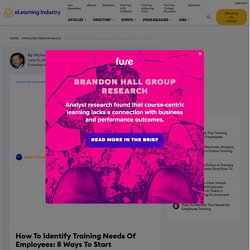
Why? Companies that skip the crucial first step, which is a Training Needs Analysis, may find their training ineffective on every level. Knowing how to identify the training needs of employees is the foundation on which your entire training is built. Cómo identificar necesidades del cliente. Cómo reconocer las necesidades de los clientes y rentabilizarlas. 10 Tips for Creating an Optimistic Workplace. Do your employees have hope that good things will come from their hard work?

"Good things" is subjective. Typically, however, it refers to feeling optimistic about personally benefiting and seeing others benefit from doing your best work. This is the hallmark of an optimistic workplace. When workplace optimism is present, employees believe in possibility rather than idolizing problems. 5 ways to become the optimistic leader your team wants. Do you think of yourself as an optimistic person?
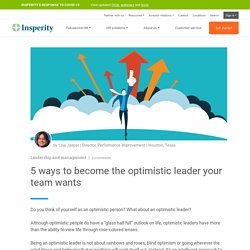
What about an optimistic leader? Although optimistic people do have a “glass half full” outlook on life, optimistic leaders have more than the ability to view life through rose-colored lenses. Being an optimistic leader is not about rainbows and roses, blind optimism or going wherever the wind blows and believing that everything will work itself out. Instead, it’s an intelligent approach to reframing how you think about business.
Build employee loyalty: 5 easy steps to show you how. As a company owner, have you considered how your employees feel about their jobs?
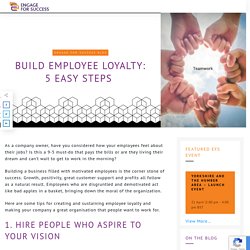
Is this a 9-5 must-do that pays the bills or are they living their dream and can’t wait to get to work in the morning? Building a business filled with motivated employees is the corner stone of success. Growth, positivity, great customer support and profits all follow as a natural result. Employees who are disgruntled and demotivated act like bad apples in a basket, bringing down the moral of the organization. Cómo reconocer las necesidades de los clientes y rentabilizarlas. 4 Impressive Ways Great Leaders Handle Their Mistakes. All leaders make mistakes. To be human means to mess up once in a while.
But the difference between good leaders and great ones lies in how they handle those mistakes. What are you modeling to those around you when you make a mistake? Your team will be watching, and what they see will affect their relationship with you and the level of trust they hold for you, so it's important to get it right. Strategies for Learning from Failure. Reprint: R1104B Many executives believe that all failure is bad (although it usually provides lessons) and that learning from it is pretty straightforward.

The author, a professor at Harvard Business School, thinks both beliefs are misguided. In... The wisdom of learning from failure is incontrovertible. How to Inspire Innovation and Learn From Mistakes. Story Highlights Most workers say their companies don't encourage them to innovateCommand-and-control management can create cultures of silenceManagers must create opportunities where employee concerns can be heard When employees know something is going wrong -- but say nothing -- companies suffer.
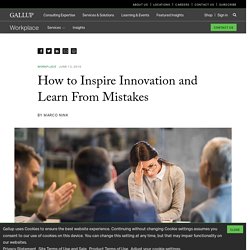
Remember the exploding Samsung Galaxy Note 7? A Step-by-Step Guide to Developing Growth Mindset in Your Team. The most successful teams and workplaces are known to be oriented on growth.
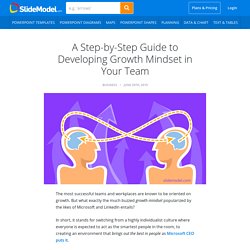
But what exactly the much buzzed growth mindset popularized by the likes of Microsoft and LinkedIn entails? In short, it stands for switching from a highly individualist culture where everyone is expected to act as the smartest people in the room, to creating an environment that brings out the best in people as Microsoft CEO puts it. In this post we’ll talk about what it takes to build a learning-oriented culture at the workplace and how managers can help their teams switch from fixed mindset to the growth one.
What is Growth Mindset? Be a Successful Change Leader: The 3 Cs of Change Initiatives. Great Change Leaders Focus on People & Process Successful change is one of the biggest problems that modern organizations face. In our fast-changing world, the strategic imperative to change is often clear: Without doing things differently, our company is unlikely to succeed, or last. But change-management research has demonstrated time after time that organizational change initiatives fail more often than they succeed, despite the resources put into creating change management processes. We know that effective leadership is essential to successful change.
But we wanted to understand the differences in leadership between successful and unsuccessful change efforts. How To Create Change When You're Not In Charge. What does the name Thomas Wilson mean to you?

Probably not much. But over a decade ago, this young man created a groundswell of change in a massive Federal organization that altered thousands of lives for the better; including mine. How did he do it? How to Create Change in Your Organization. “Everything changes and nothing stands still.” –Heraclitus, As quoted by Plato in Cratylus How do you build the capacity for continuous innovation within a company? How to Lead Your Team Through Change. August 1, 2014 5 min read Opinions expressed by Entrepreneur contributors are their own. Business demands fluidity, which requires leaders to embrace change and take risks. Put simply, if you’re not ready to lead change then you’re not ready to lead full stop. Mark Zuckerberg once said, “In a world that's changing really quickly, the only strategy that is guaranteed to fail is not taking risks,” and he was right.
Leadership is not a static endeavor. How To Lead Change: 3 Simple Steps. First the bad news: If you’re not willing to embrace change you’re not ready to lead. Put simply, leadership is not a static endeavor. In fact, leadership demands fluidity, which requires the willingness to recognize the need for change, and finally, the ability to lead change. Now the good news: As much as some people want to create complexity around the topic of leading change, the reality is creating, managing and leading change is really quite simple. To prove my point, I’ll not only explain the entire change life-cycle in three short paragraphs, but I’ll do it in simple terms anyone can understand.
8 Principles for Leading Successful Organizational Change. Managing Organizational Change. La organización del futuro: un nuevo modelo para un mundo de cambio acelerado. What is Change Management and How Does it Work? Leading organizational transformations. Creating a Culture of Innovation - Google Workspace. Google's eight pillars of innovation. Creating an innovation culture. 10 Measures to create a culture of innovation. Creating the Innovation Culture and Why It's Important Today. 6 Ways Leaders Can Build a Culture of Innovation.
Seven Steps to Creating A Culture Of Innovation. How to create a culture of innovation. 10 Tips for Building a Feedback Culture. Building a Feedback-Rich Culture. 6 Ways To Build A Feedback Driven Culture That Inspires Healthy Communication. The Importance Of A “Feedback Culture” – And How You Can Build It In The Workplace. 5 Steps for Becoming a Visionary Leader. Visionary Leadership Has 3 Key Characteristics. 14 Traits of Visionary Leaders. 9 Steps to Help You Become a Visionary Leader at Work - Life Coach Spotter. How To Be a Better Visionary Leader. How To Be A Visionary Leader. 11 Ways to Become a Visionary Leader. How to be a Visionary Leader. The Importance of Practicing Humility at Work - Idealist Careers. 7 Things You Could Do to be More Humble. Use Humility to Improve Performance. How to Infuse Your Company Culture with Humility. 7 Ways Modest Leadership Increases Team Success. Humidity: the surprising factor that can impact employee wellbeing.
3 Positive Psychology Tools. What is Positive Mindset: 89 Ways to Achieve a Positive Mental Attitude. 7 Techniques for Positive Thinking « Sabre India. 7 Super Easy Ways To Create A Positive Organizational Work Culture. El Club de las Buenas Decisiones - Formación para Empresarios, Managers y Directivos. Tres formas de mejorar tu adaptabilidad y gestionar tu vida. Claves para que aprenda a adaptarse al cambio en momentos de adversidad - Forbes Colombia. El arte de ser flexibles. 'Stretching mental': la gimnasia para flexibilizar paradigmas ante el nuevo mundo. Gestión del cambio: Qué es, competencias clave y checklist ✅ Seven ways to make your team more adaptable to change - Viewpoint Viewpoint – careers advice blog. 5 claves para gestionar adecuadamente un proyecto de mejora empresarial.
Cómo superan las grandes empresas los desafíos comunes de la gestión de proyectos. How To Overcome Challenges in the Workplace. Continuous Improvement Process: The Complete Guide. Embracing change in the workplace. Estimular el Autodesarrollo – Humant Talent. Autodesarrollo: 4 pasos hacia un liderazgo más sólido. Plan de autodesarrollo - Superación personal. El concepto de autodesarrollo en las organizaciones. ACMP Lean » Pautas y herramientas para identificar problemas en la empresa. Cómo convertir los problemas en oportunidades mediante soluciones creativas. ¿Cómo Promover la Cultura de Aprendizaje? - PMK Psicomarketing. La importancia del aprendizaje continuo en las empresas. Cuatro formas de crear una cultura de aprendizaje continuo. 4 maneras de crear una cultura de aprendizaje en su equipo. Formación continua en la empresa. Todas las claves. Haz del aprendizaje corporativo una actividad recurrente.
Adoptar una mentalidad de crecimiento para impulsar la empresa - The Adecco Group Institute. Cultura de aprendizaje continuo: SkillBank de Telefónica. Movilizar personas en una organización en cambio. La reconversión del aprendizaje en las organizaciones. Cómo superan las grandes empresas los desafíos comunes de la gestión de proyectos. ¿Es más difícil aprender de adultos? Mariano Sigman, neurocientífico.
"Si te han dicho que no puedes aprender algo es mentira". Mariano Sigman, neurocientífico. Estrategias para aprender mejor. Barbara Oakley, educadora y escritora. Youtube. Youtube. 10 claves del trabajo en equipo. El obstáculo #1 del trabajo en equipo es la actitud defensiva. Aquí te decimos como manejarla. Jim Hemerling: 5 ways to lead in an era of constant change. “Las 17 cualidades esenciales de un jugador de equipo” – ECTVPLAYMOTIVACIÓN. ¿Cuáles son las reglas básicas del trabajo en equipo?
11 pasos para planificar un buen proyecto. Obsbusiness. ¿Qué es la planificación de un proyecto? 7 pasos básicos para un proceso de planificación. 6 Pasos para una planificación de tareas exitosa. Cómo Iniciar un Proyecto Correctamente: Una Guía Completa Para la Iniciación de Proyectos. Cómo gestionar un proyecto con éxito (las claves que debes saber)